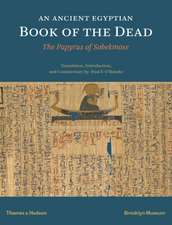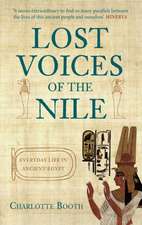The Excavations of Beth Shemesh, November-December 1912: The Palestine Exploration Fund Annual
Autor Duncan MacKenzie, Shlomo Bunimovitz, Zvi Lederman, Nicoletta Momiglianoen Limba Engleză Hardback – 18 iul 2016
In 1992 Nicoletta Momigliano rediscovered Mackenzie’s lost manuscript on his latest discoveries at Beth Shemesh, which one of his nephews had kept for nearly 80 years at his old family home in the Scottish Highlands, in the small village of Muir of Ord. At about the same time, Shlomo Bunimovitz and Zvi Lederman initiated new excavations at Beth Shemesh which considerably changed previous interpretations of the site. This volume presents Mackenzie’s detailed discussion of his last excavations at Beth Shemesh in the light of these more recent discoveries. Although written over a century ago, Mackenzie’s manuscript deserves to be better known today; it not only provides significant new information on this important site but also constitutes an intriguing historical document, shedding light on the history of field archaeology and of biblical archaeology. Moreover, Mackenzie’s pioneering approach to archaeological fieldwork and the significance of his finds can often be better appreciated today, from the perspective of more recent developments and discoveries.
| Toate formatele și edițiile | Preț | Express |
|---|---|---|
| Paperback (1) | 272.50 lei 6-8 săpt. | |
| Taylor & Francis – 12 dec 2019 | 272.50 lei 6-8 săpt. | |
| Hardback (1) | 770.31 lei 6-8 săpt. | |
| Taylor & Francis – 18 iul 2016 | 770.31 lei 6-8 săpt. |
Preț: 770.31 lei
Preț vechi: 1031.00 lei
-25% Nou
Puncte Express: 1155
Preț estimativ în valută:
147.42€ • 152.29$ • 122.69£
147.42€ • 152.29$ • 122.69£
Carte tipărită la comandă
Livrare economică 26 martie-09 aprilie
Preluare comenzi: 021 569.72.76
Specificații
ISBN-13: 9781138640740
ISBN-10: 1138640743
Pagini: 164
Ilustrații: illustrations
Dimensiuni: 219 x 274 x 16 mm
Greutate: 0.79 kg
Ediția:1
Editura: Taylor & Francis
Colecția Routledge
Seria The Palestine Exploration Fund Annual
Locul publicării:Oxford, United Kingdom
ISBN-10: 1138640743
Pagini: 164
Ilustrații: illustrations
Dimensiuni: 219 x 274 x 16 mm
Greutate: 0.79 kg
Ediția:1
Editura: Taylor & Francis
Colecția Routledge
Seria The Palestine Exploration Fund Annual
Locul publicării:Oxford, United Kingdom
Cuprins
Preface vii
Acknowledgements ix
List of Illustrations x
Abbreviations xiii
1. Introduction N. Momigliano, S. Bunimovitz and Z. Lederman 1
1.1. Duncan Mackenzie’s life and work: a brief overview N. Momigliano 1
Works by Duncan Mackenzie N. Momigliano 7
1.2. Mackenzie’s work at Beth Shemesh S. Bunimovitz, Z. Lederman and N. Momigliano 8
1.3. Work conducted at the site after Mackenzie S. Bunimovitz and Z. Lederman 11
Elihu Grant’s excavations (1928–33) 11
The renewed excavations (1990 to the present) 11
Middle and Late Bronze Ages 12
Iron Age I 14
Iron Age IIA 15
Iron Age IIB–C 18
1.4. Mackenzie’s manuscript on the third campaign of excavations at Beth Shemesh
of November–December 1912: its rediscovery and transcription N. Momigliano 20
2. Transcription: The excavations of Beth Shemesh November–December, 1912
Duncan Mackenzie (transcription and notes by N. Momigliano) 25
2.1. Further Investigations in the Area of the South Gate 25
2.2. The City Well of Beth Shemesh 33
2.3. The Exploration of the High Place Grotto Sepulchre 41
2.4. The Pottery of the High Place Grotto: First Beth Shemesh Period 45
2.5. The Hypogeum in the Area of the High Place 49
2.6. The Hypogeum-cistern by the Olive Press 54
2.7. Further Excavations in the Central City Area 65
2.8. The Stratification of the Deposits 67
2.9. The Deposits of the First Period 71
2.10. The Deposits of the Second Period 75
2.11. The Deposits of the Third or Israelite Period 82
2.12. The Deposits of the Period of Re-occupation 89
2.13. The Olive Press 93
2.14. Small Finds from the City Site of Beth Shemesh 97
vi the excavations of beth shemesh
3. Mackenzie’s third campaign at Beth Shemesh in the light of the renewed excavations
at the site S. Bunimovitz and Z. Lederman 108
3.1. The renewed excavations of the South Gate 108
The eastern gate tower 108
The western gate tower 111
The gate passage 111
The gate’s construction 111
The end of the South Gate 113
3.2. ‘Water of Beth Shemesh’: The ‘City Well’ and underground water reservoirs of
Beth Shemesh 117
The City Well 117
The hypogea in the Central City Area 118
Deciphering depositional processes: water drawing and its aftermath 119
Sequencing the water installations at Beth Shemesh 122
3.3. The High Place Grotto Sepulchre, a Middle Bronze Pre-fortification Phase? 123
3.4. The Central City Area Deposits, from the First to the Third Periods 124
The deposits of the First Period 124
The deposits of the Second Period 126
The deposits of the Third Period 130
Mackenzie’s revised stratigraphical scheme of the First to Third Periods at
Beth Shemesh 131
3.5. Deconstructing the Myth of the Reoccupation at Beth Shemesh 131
3.6. Mackenzie’s Olive Press and the Iron Age IIB Oil Industry at Beth Shemesh 134
3.7. Small Finds: The Iron Age Sickle Blades of Beth Shemesh 139
Bibliography 142
Index 146
Acknowledgements ix
List of Illustrations x
Abbreviations xiii
1. Introduction N. Momigliano, S. Bunimovitz and Z. Lederman 1
1.1. Duncan Mackenzie’s life and work: a brief overview N. Momigliano 1
Works by Duncan Mackenzie N. Momigliano 7
1.2. Mackenzie’s work at Beth Shemesh S. Bunimovitz, Z. Lederman and N. Momigliano 8
1.3. Work conducted at the site after Mackenzie S. Bunimovitz and Z. Lederman 11
Elihu Grant’s excavations (1928–33) 11
The renewed excavations (1990 to the present) 11
Middle and Late Bronze Ages 12
Iron Age I 14
Iron Age IIA 15
Iron Age IIB–C 18
1.4. Mackenzie’s manuscript on the third campaign of excavations at Beth Shemesh
of November–December 1912: its rediscovery and transcription N. Momigliano 20
2. Transcription: The excavations of Beth Shemesh November–December, 1912
Duncan Mackenzie (transcription and notes by N. Momigliano) 25
2.1. Further Investigations in the Area of the South Gate 25
2.2. The City Well of Beth Shemesh 33
2.3. The Exploration of the High Place Grotto Sepulchre 41
2.4. The Pottery of the High Place Grotto: First Beth Shemesh Period 45
2.5. The Hypogeum in the Area of the High Place 49
2.6. The Hypogeum-cistern by the Olive Press 54
2.7. Further Excavations in the Central City Area 65
2.8. The Stratification of the Deposits 67
2.9. The Deposits of the First Period 71
2.10. The Deposits of the Second Period 75
2.11. The Deposits of the Third or Israelite Period 82
2.12. The Deposits of the Period of Re-occupation 89
2.13. The Olive Press 93
2.14. Small Finds from the City Site of Beth Shemesh 97
vi the excavations of beth shemesh
3. Mackenzie’s third campaign at Beth Shemesh in the light of the renewed excavations
at the site S. Bunimovitz and Z. Lederman 108
3.1. The renewed excavations of the South Gate 108
The eastern gate tower 108
The western gate tower 111
The gate passage 111
The gate’s construction 111
The end of the South Gate 113
3.2. ‘Water of Beth Shemesh’: The ‘City Well’ and underground water reservoirs of
Beth Shemesh 117
The City Well 117
The hypogea in the Central City Area 118
Deciphering depositional processes: water drawing and its aftermath 119
Sequencing the water installations at Beth Shemesh 122
3.3. The High Place Grotto Sepulchre, a Middle Bronze Pre-fortification Phase? 123
3.4. The Central City Area Deposits, from the First to the Third Periods 124
The deposits of the First Period 124
The deposits of the Second Period 126
The deposits of the Third Period 130
Mackenzie’s revised stratigraphical scheme of the First to Third Periods at
Beth Shemesh 131
3.5. Deconstructing the Myth of the Reoccupation at Beth Shemesh 131
3.6. Mackenzie’s Olive Press and the Iron Age IIB Oil Industry at Beth Shemesh 134
3.7. Small Finds: The Iron Age Sickle Blades of Beth Shemesh 139
Bibliography 142
Index 146
Descriere
In 1909 the Scottish archaeologist Duncan Mackenzie was appointed ‘Explorer’ of the Palestine Exploration Fund (PEF). From the spring of 1910 until December 1912 he was engaged in archaeological fieldwork in Palestine, especially directing excavation campaigns at Ain Shems (biblical Beth Shemesh) – an important site in the Shephelah of Judah at the crossroads of Canaanite, Philistine, and Israelite cultures. Mackenzie published the results of his work in various issues of the Palestine Exploration Quarterly and Palestine Exploration Fund Annual. Because of a financial dispute with the PEF, however, he never submitted a detailed publication of his very last campaign at Beth Shemesh, conducted in November–December 1912.
In 1992 Nicoletta Momigliano rediscovered Mackenzie’s lost manuscript on his latest discoveries at Beth Shemesh. At about the same time, Shlomo Bunimovitz and Zvi Lederman initiated new excavations at Beth Shemesh which considerably changed previous interpretations of the site. This volume presents Mackenzie’s detailed discussion of his last excavations at Beth Shemesh in the light of these more recent discoveries. Although written over a century ago, Mackenzie’s manuscript deserves to be better known today; it not only provides significant new information on this important site but also constitutes an intriguing historical document, shedding light on the history of field archaeology and of biblical archaeology. Moreover, Mackenzie’s pioneering approach to archaeological fieldwork and the significance of his finds can often be better appreciated today, from the perspective of more recent developments and discoveries.
In 1992 Nicoletta Momigliano rediscovered Mackenzie’s lost manuscript on his latest discoveries at Beth Shemesh. At about the same time, Shlomo Bunimovitz and Zvi Lederman initiated new excavations at Beth Shemesh which considerably changed previous interpretations of the site. This volume presents Mackenzie’s detailed discussion of his last excavations at Beth Shemesh in the light of these more recent discoveries. Although written over a century ago, Mackenzie’s manuscript deserves to be better known today; it not only provides significant new information on this important site but also constitutes an intriguing historical document, shedding light on the history of field archaeology and of biblical archaeology. Moreover, Mackenzie’s pioneering approach to archaeological fieldwork and the significance of his finds can often be better appreciated today, from the perspective of more recent developments and discoveries.





















